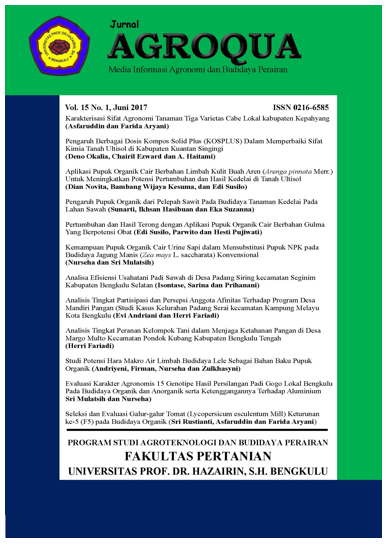UJI TOKSISITAS HERBISIDA FORMULASI PADA ORGANISME NON TARGET CACING TANAH
DOI:
https://doi.org/10.32663/ja.v20i1.2699Keywords:
environmentally friendly, herbicide, lethal concentration (LC50), formulationAbstract
This study aims to determine the toxicity of the formulated herbicide concentration to non-target organisms (non-target) earthworms. The study was conducted from April to July 2021. The design used was a completely randomized design (CRD) with nine (9) herbicide concentrations (K) treatments, namely: K0 = control, K1 = 200 ppm concentration (0.2 ml/l water ), K2 = concentration of 400 ppm (0.4 ml/ l of water), K3 = concentration of 600 ppm (0.6 ml/ l of water), K4 = concentration of 800 ppm (0.8 ml/ l of water), K5 = concentration 1000 ppm (1.0 ml/ l of water), K6 = concentration of 1200 ppm (1.2 ml/ l of water), K7 = concentration of 1400 ppm (1.4 ml/ l of water), K8 = concentration of 1600 ppm (1, 6 ml/l water). Each treatment was repeated 3 times. The observed variables were mortality concentration 50 (LC50) for 96 hours, survival rate, mortality percentage and worm weight. This study concluded that the mortality concentration of 50 (LC50) for 96 hours from the formulated herbicide against earthworms was 600 ppm, while the 100% mortality occurred at the herbicide concentration of 1400 ppm. The lowest survival rate was found at a concentration of 1400 ppm, where at that concentration all the test worms died. Meanwhile, the highest survival rate after the herbicide was 200 ppm where the worm mortality was 20%. The higher the concentration of herbicide formulation given to earthworms, the higher the mortality rate and decrease in body weight.
References
Downloads
Published
Issue
Section
License
Authors who publish with this journal agree to the following terms:
- Authors grant the journal right of first publication with the work simultaneously licensed under a Creative Commons Attribution 4.0 Internasional (CC BY 4.0) Licence that allows others to use and share the work with an acknowledgment of the work's authorship and initial publication in this journal.
- The author(s) still hold the copyright of his/her/their work and retain publishing rights without restrictions such as (but not limited to) patent right, lecture, book and reproduce the article for own purposes.
















